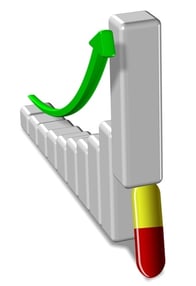 Although the condition of your pharmacy workflow likely goes unnoticed by your customers, often hidden from view in the back end of the store, you can bet that the effects of the operations back there are apparent to customers and employees alike. When things are running efficiently back in the "employees only" area, everyone's happy and satisfied with the level of service being provided. When operations are bogged down, however, everyone suffers – and so does your store's bottom line.
Although the condition of your pharmacy workflow likely goes unnoticed by your customers, often hidden from view in the back end of the store, you can bet that the effects of the operations back there are apparent to customers and employees alike. When things are running efficiently back in the "employees only" area, everyone's happy and satisfied with the level of service being provided. When operations are bogged down, however, everyone suffers – and so does your store's bottom line.
Signs and Symptoms of an Inefficient Pharmacy Workflow
The first and most obvious sign of workflow inefficiency is an increase in prescription filling wait times. When things are moving too slowly and customers are kept cooling their heels waiting for their medicine, their level of satisfaction will soon begin to plummet and thoughts of taking their business elsewhere may start to creep in. One of the main factors that allows small, independent pharmacies to compete with the many big-box pharmacies out there is the ability to provide an exceptional level of personalized, friendly, and speedy service. When this isn't present, a major customer benefit is lost.
An approachable, trusted pharmacist can have a major impact on the health and well-being of community members in the performance of their duties, but only if this individual is available to meet and consult with patients one-on-one. Customers want to have a friendly relationship and good rapport with a pharmacist who knows their needs and is willing to take time out to visit with them, consulting on applicable health concerns and providing ancillary services like taking blood pressure readings or giving immunizations.
How an Improved Pharmacy Workflow Helps
All too often, especially when back-room workflows are less than optimal, the pharmacist is stuck in the back, hidden from view, and it's their less-qualified assistants who are out talking to the public and dispensing advice. Improving pharmacy workflow will save time and improve service quality, giving appropriate and doable tasks to the technicians while freeing up the pharmacist to spend more time consulting and otherwise catering to customer needs. The installation of automated equipment, such as robotic pill dispensing machines, can help streamline operations significantly. Rearranging the back work area so that less walking, bending, and reaching is needed to complete individual tasks can also help speed up tasks.
How Pharmacy Workflow Impacts Your Bottom Line
Anything that engenders customer dissatisfaction will have a negative impact on your pharmacy's bottom line, and a sub-par workflow behind the scenes can be a major contributor to satisfaction problems. Some examples include:
- Inordinately long wait times for getting prescriptions filled may cause clients to become impatient and decide to go elsewhere.
- Inefficiencies that cause the pharmacist to be stuck in the back away from customers may cause those customers to feel neglected. They may consider going to a competitor instead.
- Backroom chaos can create unwanted stress among employees. This may contribute to a higher employee turnover rate due to job dissatisfaction as well as cause interactions with customers to be less friendly and relaxed.
- A disorganized pharmacy workflow opens up the potential for medication dispensing mistakes, which are not only bad for business but potentially dangerous as well.
Improved workplace organization can go a long way toward improving customer satisfaction and employee morale. Poor organization is typically the product of the lack of a deliberate design to promote efficiency, which can be remedied through the installation of well-organized workstations, updated technology, and improved storage and inventory methods.




